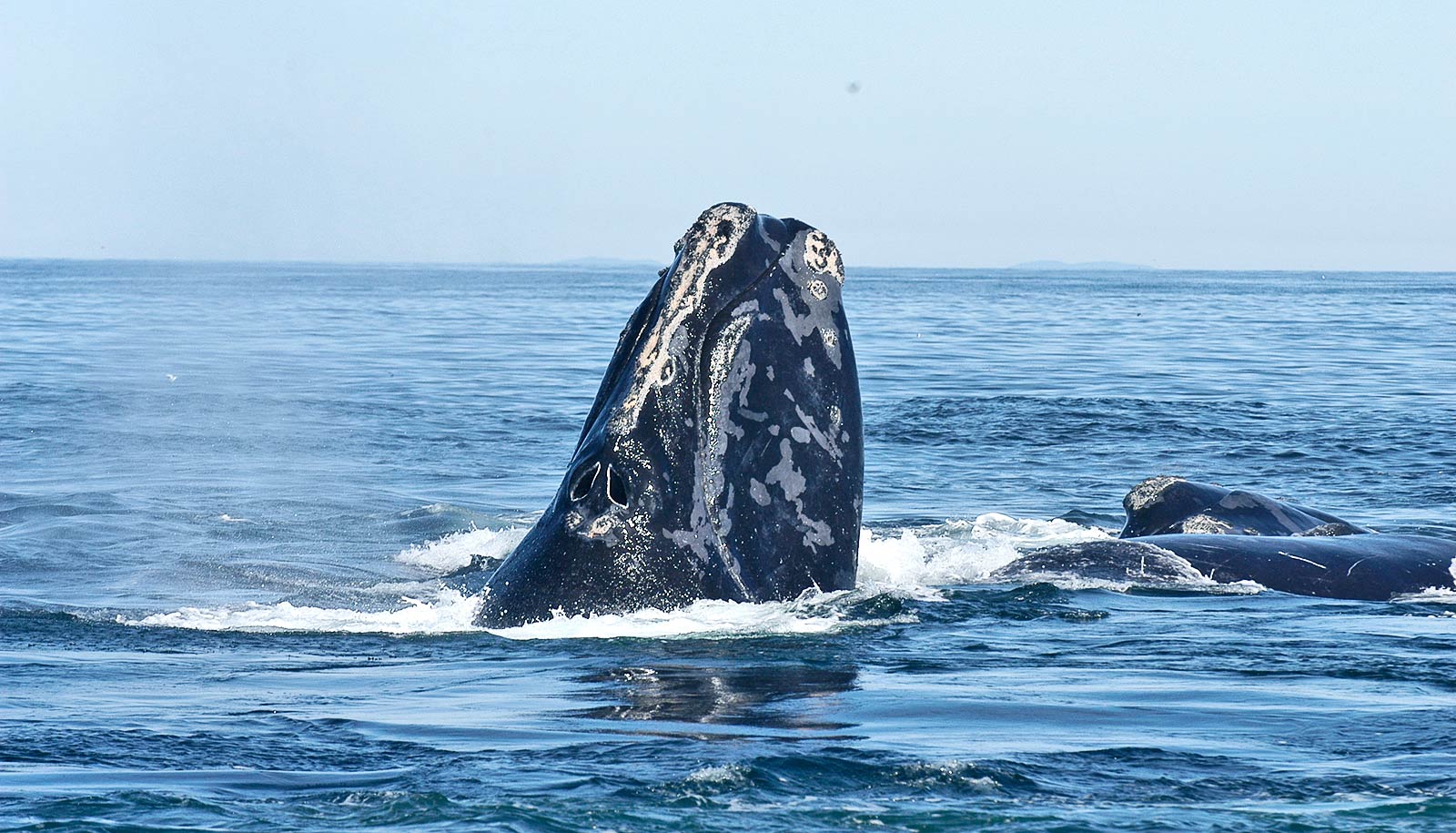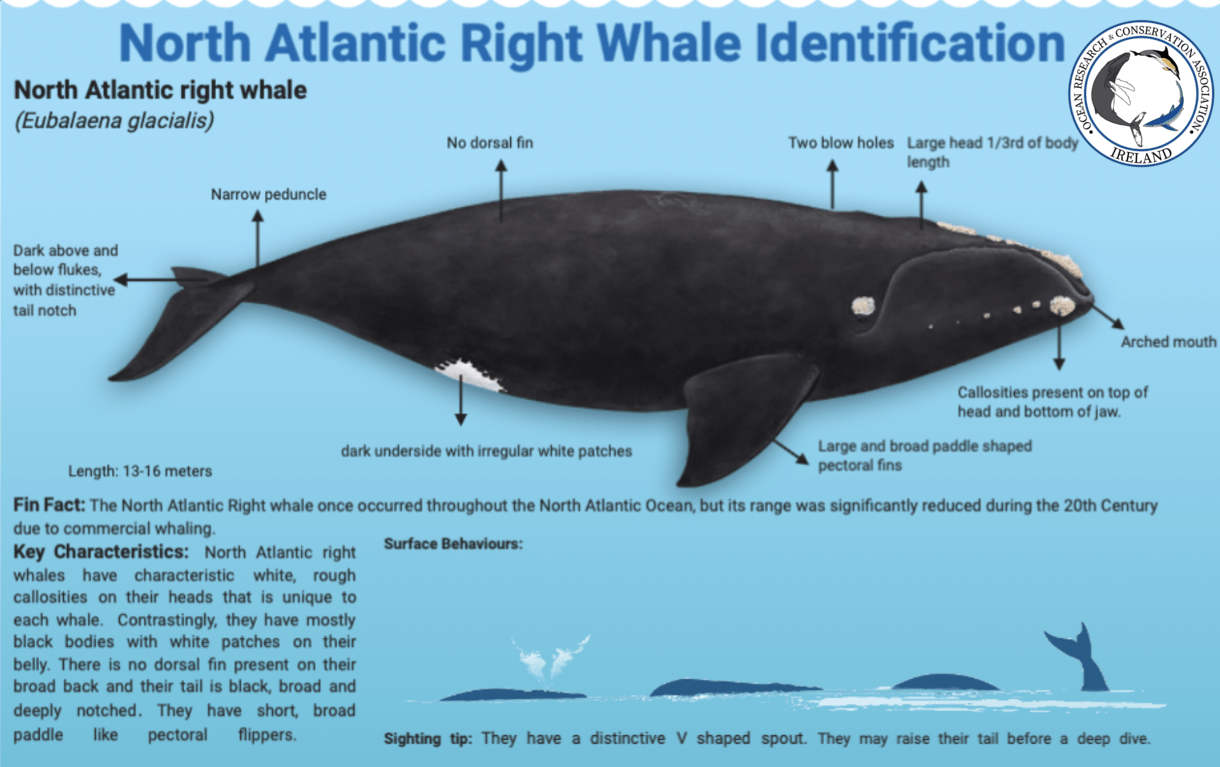Classification:
Kingdom: Animalia
Phylum: Chordata
Class: Mammalia
Order: Artiodactyla
Infraorder: Cetacea
Family: Balaenidae
Genus: Eubalaena
Species: glacialis
Get the Facts:
The North Atlantic Right whale once occurred throughout the North Atlantic Ocean, but its range was significantly reduced during the 20th Century due to commercial whaling. Today the North Atlantic right whale has been declared as critically endangered by the IUCN ; in fact, it is one of the most endangered large whale species in the world with only 411 individuals estimated to remain in a western Atlantic population as of 2017. In the early 1980s they were hunted to the point of being extinct as they were targeted for their oil, meat and bones. They have not yet been able to recover from three centuries of whaling. North Atlantic right whales once seasonally occurred off Ireland's north-west coasts, likely from an eastern Atlantic population that ranged from Northwest Africa to Europe, as far north as Norway, that has been now been declared functionally extinct. Today the biggest threat to the survival of the remaining whales from the western population, which is in decline (1% per year from 2010-2015, includes entanglement in fishing gear, ship strike and climate change.
Species Identification:
North Atlantic right whales are one of the largest cetacean species on earth weighing up to 70 tons and growing up to 16 meters in length. At birth they can measure in at 4.3 meters. Their heads can measure up to one third of their body length. They have a long, prominent, arching mouth that starts at their eye which has hundreds of baleen plates which are 3m each. They have a distinctive V shaped spout. North Atlantic right whales have characteristic white, rough callosities on their heads that is unique to each whale. This can be used by scientists to identify these whales. Whale lice can be found on the callosities which is responsible for the callosities’ colour. Contrastingly, they have mostly black bodies with white patches on their belly. There is no dorsal fin present on their broad back and their tail is black, broad and deeply notched. They have short, broad paddle like pectoral flippers.
Similar Species:
Similar species to the North Atlantic Right Whale are the two other right whale species. The North Pacific right whale inhabits the Pacific Ocean and the Southern right whale lives in the southern hemisphere.
Diet:
North Atlantic right whales are filter feeding baleen whales that feed on zooplankton such as copepod, krill and small invertebrates. They swim slowly with their mouths open through dense patches of zooplankton either with their heads breaching the water's surface or deeper in the water column near the seabed. This feeding mechanism is known as skim feeding or grazing. Then they use their large baleen plates to strain out the prey from the water before ingesting the prey. They eat up between 2200 to 5500 pounds of food per day!
Habitat:
The North Atlantic right whale inhabits coastal waters along continental shelves in the Atlantic Ocean and tend to travel deeper in the water column. The earliest records of North Atlantic Right whales in Irish waters dates back to 1737, and the most recent to the year 2000, with records occurring in May, June and August, according to the National Biodiversity Data Centre.
Behaviour:
North Atlantic right whales can be easily spotted if nearby as they put on quite a show. They are known to leap and break through the water’s surface, landing back in with a massive crash. They also famously slap their tails against the water’s surface. They are seasonal migrators and swim long distances when foraging and during calving. These whales are not fast swimmers and swim slow and leisurely especially when feeding .They use their massive baleen plates to feed on zooplankton. They communicate using low frequency vocalisations.
Social Structure:
Right whales migrate seasonally and may travel alone or in small groups. At the water’s surface they actively socialise in groups called a surface active group (SAG). They may also swim with other cetaceans.
Reproduction:
Female North Atlantic right whales become sexually mature at 10 years old whereas for males, this is usually between 5-10 years. Mating occurs in the SAG group in the winter months and these relationships are known to be short lived due to the polygamous behaviour displayed. The female may mate with multiple males and the males usually do not provide any sort of parental care. After becoming pregnant, pregnancy in these whales usually last a year and the female spends another year nursing calves in the warm, shallow nursery grounds. At birth, the calf measures in at 4.5-6 meters. The female North Atlantic right whale gives birth to one live calf every 3-5 years. Male North Atlantic right whales have the largest testes of mammals weighing in at 525kg. Approximately there are 95 reproductive females.
Vocalisations:
The vocalisations of North Atlantic right whales are low frequency noises such as moans and groans less than 500 Hz. This low frequency noise may be simple or complex and are used for communication purposes or used for socialisation. This vocalisation lasts about only 2 seconds from around 50-440 Hz and is known as an “up call” which is produced by all ages and sexes. Males can also produce “gunshot” noise which can be used to impress females or to intimidate other males. Scream calls can be produced by the focal female in the SAG who forms and maintains the group at 0.5-2.8 seconds between 400 to 3200 Hz.
Lifespan:
North Atlantic right whales have a life span of approximately 70 years. After death, ear wax can be used to determine the age of the whale.
Right whales of the world:
Right whales or black whales are three species of large baleen whales of the genus Eubalaena: the North Atlantic right whale (E. glacialis), the North Pacific right whale (E. japonica) and the Southern right whale (E. australis). They are classified in the family Balaenidae with the bowhead whale.
Right whale Global Distribution:
Hunting of the North Atlantic right whale significantly decreased its distribution in the North Atlantic. Presently, their migration pattern throughout the year and global distribution is guided by their feeding and calving behaviour. For foraging and feeding in the early months of the year, during spring and summer, North Atlantic right whales can be found in the western North Atlantic off the east coast of the United States and Canada with a few individuals venturing to Iceland, Norway and England. During the calving season, from fall to winter, these whales migrate to waters that are warmer, shallow and more suitable to act as a nursery ground for their calves. These areas include South Carolina, Georgia and northeastern Florida. The distance they travel during this migration is over 1000 miles. Although this can be described as the general distribution pattern, not all North Atlantic right whales adhere to this pattern.
Population Status:
North Atlantic right whales are critically endangered. There are approximately 400 animals that exists, less than 250 of which are adults.
Threats to survival:
North Atlantic right whales have been threatened in the past by whaling which they seem to have not yet fully recovered. They are currently listed as critically endangered and are now prone to endangerment from accidents with fishing vessels and fishing gear. These accidents are primary threats causing serious injury and even mortality. Their feeding behaviour of grazing at the water’s surface and their migratory behaviour make them easy targets to get accidentally struck by boats. Stress from entanglement can also endanger their calving. In addition exploration for oil and gas poses threats to these marine mammals. Noise pollution underwater also poses a threat as it disrupts communication between whales.






